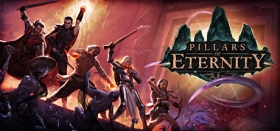
E3 2014 - Pillars of Eternity Preview
Paradox Interactive and Obsidian Entertainment have gone old-school for Pillars of Eternity, a huge Kickstarter success and spiritual successor to the Baldur’s Gate series.
Based on a closed-door preview of the game, it’s clear Obsidian hasn’t lost its touch, despite the ten-year gap between Pillars of Eternity and the last Baldur’s Gate installment. Like its spiritual predecessor, Eternity is an isometric (or “3/4 perspective,” where the player’s view is not quite perpendicular to the map) RPG and relies on textbox dialogue that gives players a number of responses to choose from, which can affect the course of the game. However unlike Baldur’s Gate, Eternity will not be based on modified Dungeons and Dragons rules (a relatively common trend in RPGs of the era) and will instead feature entirely new intellectual property from Obsidian.
Eternity seems to offer players the full old-school RPG experience, from click-to-move exploration down to blinking circular character markers, but doesn’t let itself get mired in paying homage to its predecessors. Aside from just choosing their class, players can customize their backstory in Eternity as well, which can affect events further down the line. Dialogue choices are tracked throughout the game, and develop a reputation for a character based on the game’s disposition system.

For Paradox’s press demo, lead designer Brandon Adler showed off a male mage who’s travelling as part of a caravan destined for Gilded Vale, where a local lord is giving away land to homesteaders. Of course, this trip doesn’t go smoothly (it’s an RPG after all—nothing goes smoothly) and after a fallen tree and a general sense of foreboding stop the travelers for the night, Eternity introduces the concept of a Soulstorm. This mystical “weather” that rips the souls from any living thing that has the misfortune of being in its path, and when one hits the group’s campsite it scatters the travelers, forcing our mage and the members of his impromptu party—Calisca the warrior and the rogue Heodan—into some nearby ruins.
Here, Eternity gives us the first glimpse of how dungeon-crawls (or other extended bouts of repetitive combat) play out. While the game occurs in real time, combat gives players the ability to pause and make use of the tactical aspects of their party. Abilities use stamina, which players need to monitor almost as closely as their health: when a character’s stamina hits zero, they’re knocked out. Health on the other hand, slowly depletes outside of combat as well, and players must rest their party periodically to restore it. However, resting in the wider world requires camping supplies and the number a party can carry is limited by the game’s difficulty setting.
In between fighting spiders and Xaurips (Eternity’s version of DnD Kobolds), it also becomes apparent that the game lacks much of the linear design players often expect from an RPG, instead relying on exploration and trial-and-error. The party, for example, discovers a hammer and chisel while exploring the ruins, which later come in handy when they’re faced with a false wall. Had the player missed the hammer and chisel (which were hidden in a dead end a ways away) they would have had to find another solution—either an alternate way to break through, or a different route.

Eternity also introduces what Obsidian refers to as “storybook moments”, which are scripted events that are told through pen-and-ink style illustrations and narrative text. These are present for the game’s “high-impact” moments, and provide a more dramatic telling of crucial plot points.
With Pillars of Eternity, Obsidian has managed to strike a solid balance between nostalgia for Baldur’s Gate and its late nineties compatriots without ending up with a game that feels…well, dated. Admittedly, much of its appeal rides on players’ rose tinted affection for those old-school DnD-inspired RPGs (myself included), but the game is not without its own merits and feels more like a tribute than a misguided attempt at a resurrection. While its target audience is without a doubt gamers who were old enough to play Baldur’s Gate and its ilk when they first came out—or several years behind the curve, like me—Pillars of Eternity should still hold some appeal for newer gamers as well, if only because it gives them a look at a gameplay style that primarily died with Windows XP.
After pushing back its release from the beginning of 2014, Pillars of Eternity is set to launch sometime towards the end of this year for PC.











COMMENTS